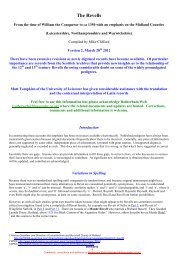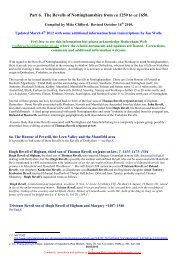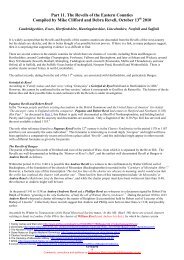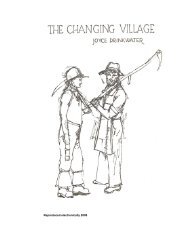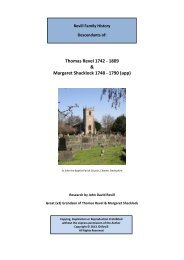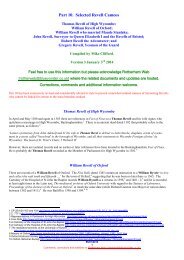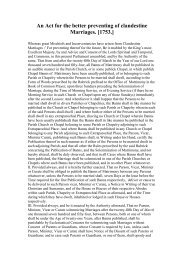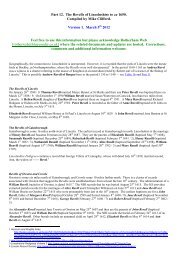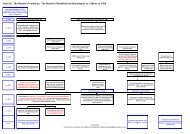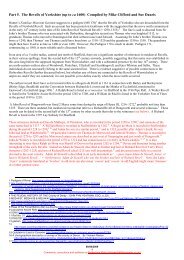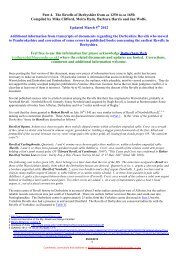Part 2. The children of William Revell of Newbold ... - Rotherham Web
Part 2. The children of William Revell of Newbold ... - Rotherham Web
Part 2. The children of William Revell of Newbold ... - Rotherham Web
Create successful ePaper yourself
Turn your PDF publications into a flip-book with our unique Google optimized e-Paper software.
marrying Alan de Kilworth [Kenilworth]. This Joan and Alan are shown as having two sons, Philip de Newnham and Robert de<br />
Newnham, 133 but dates are not given and there is no reference to a second marriage.<br />
However, consistent with the foregoing, on January 10 th 1327 / 8 the Close Rolls contain an entry as follows: 134<br />
‘To the Sheriff <strong>of</strong> Warwick. Order to restore …. Alan de Kelyngwurth, lord <strong>of</strong> Little Newenham, Clerk, whose lands, goods and<br />
chattels were taken into the king's hands upon his being charged before the king at Warrewyk with the homicide <strong>of</strong> Nicholas de<br />
Wylas, slain at Pahnton [Palinton?], and with the harbouring <strong>of</strong> divers thieves’, and it is plausible that Joan did marry twice.<br />
Harleston is ca 5 miles from Long Buckby, ca 8 miles from Watford (Northamptonshire) and ca 10 miles from Newnham and<br />
the manor is associated with the Priory <strong>of</strong> Monks Kirby.<br />
<strong>The</strong>re are two other geographically isolated records, the first <strong>of</strong> a Roger Ryuel listed at Brauncewell in the Lincolnshire Lay<br />
Subsidy in 133<strong>2.</strong> 135 <strong>The</strong> second refers to a Roger <strong>Revell</strong> ordained in 1339 as Subdeacon at Bromyard Church by John Bishop <strong>of</strong><br />
Hereford. 136 Neither seems likely to be this individual.<br />
<strong>William</strong> <strong>Revell</strong> (Ryvel) <strong>of</strong> Buckeby son <strong>of</strong> Robert <strong>of</strong> Bukkeby and grandson <strong>of</strong> <strong>William</strong> <strong>Revell</strong> <strong>of</strong><br />
<strong>Newbold</strong> <strong>Revell</strong>. Extant ? 1310–1325–1345–1380–1393 ?<br />
This <strong>William</strong> <strong>Revell</strong>’s date <strong>of</strong> birth is not known for certain, but in 1345 he is recorded explicitly as ‘<strong>William</strong> Ryvel <strong>of</strong> Buckeby’<br />
as follows:<br />
‘Acquittance by Nicholas Felicessone, reve <strong>of</strong> the manor <strong>of</strong> Hetherington, to <strong>William</strong> Ryvel, <strong>of</strong> Buckeby, for 40s. in part <strong>of</strong> 65s.<br />
wherein the said <strong>William</strong> was bound to his lord the prior <strong>of</strong> the Hospital <strong>of</strong> St. John <strong>of</strong> Jerusalem for a relief in arrear.<br />
137, 138<br />
Hetherington, Saturday after the Nativity <strong>of</strong> the B.V.M., 18 Edward III’.<br />
<strong>William</strong> <strong>Revell</strong>’s father was probably born ca 1270, and <strong>William</strong>’s daughter married no later than 1365. Together these records<br />
suggest that this <strong>William</strong> <strong>Revell</strong> was born no later than ca 1325, but his father would then have been ~55, and it is thus likely<br />
that <strong>William</strong> <strong>of</strong> Buckeby was born somewhat earlier, say in the period 1310 to 1320.<br />
It is probably this <strong>William</strong> <strong>Revell</strong> who is referred to in Bridge’s (citing Comp. Walt. Parles) as in 1346 holding ‘that part <strong>of</strong><br />
Buckby lordship as was possessed by Hugh <strong>Revell</strong> in the time <strong>of</strong> Henry III’, 139 i.e. in the period 1216 to 1272<br />
In 1347 a ‘<strong>William</strong> Ryvel <strong>of</strong> Bukkeby’ is named in an ‘Oyer and terminer’ that also refers to ‘John ' <strong>William</strong> baillyf Ryvel' <strong>of</strong><br />
Bukkeby’, 140 as follows:<br />
‘Commission <strong>of</strong> oyer and terminer to Roger Hillary, Thomas de Bukton, Henry de Grene and Nicholas de Vieleston, on<br />
complaint by Joan late the wife <strong>of</strong> Ralph Basset <strong>of</strong> Drayton that <strong>William</strong> Ryvel <strong>of</strong> Bukkeby, John ' <strong>William</strong>baillyf Ryvel' <strong>of</strong><br />
Bukkeby, Thomas Waleys, John de Shelton, Henry Bussel, <strong>William</strong> Shephurd, John Mody and others broke her close at Bukkeby<br />
and entered her free chace there, hunted in the chace, and fished in her stews there, carried away fish therefrom with other <strong>of</strong><br />
her goods as well as hares, rabbits, partridges and pheasants from the warren and assaulted her servant, Nicholas le Waryner,<br />
whereby she lost his service for a great time. By fine <strong>of</strong> 1 mark paid to the clerk <strong>of</strong> the hanaper. Northampton’. 141<br />
Matt Tompkins advises that ‘You <strong>of</strong>ten see constructions like ‘John <strong>William</strong>baillyf Ryvel’ in the records <strong>of</strong> the royal courts in<br />
the 14 th and 15 th centuries, though I don't think I've ever come across them anywhere else - they seem to be just a legal usage.<br />
<strong>The</strong>y are always applied to servants, apparently to servants who themselves lacked surnames and were known instead by<br />
their occupational relationship to their employer, though I have always suspected that, in the 15 th century at least, the<br />
individuals concerned did in fact have hereditary surnames <strong>of</strong> their own and that this unusual style was just a legal convention.<br />
Perhaps it was used when the individual's surname was not known to the lawyer or court clerk who drew up the record.<br />
Though occasionally you see examples when the servant's true surname is also given. For example in 1374 suits were brought<br />
in Common Pleas by the prior <strong>of</strong> Fordham against a man called ‘Stephen Badercours Thomasseruant Offord’ (i.e. Stephen<br />
Badercours, servant <strong>of</strong> Thomas Offord) and by Thomas Hichecokesson against John Geke, Katherine Ellesworth, widow <strong>of</strong><br />
133 <strong>The</strong> Antiquities <strong>of</strong> Warwickshire Volume 1 pages 85–86<br />
http://books.google.co.uk/books?id=EWhZAAAAYAAJ&pg=PA86&lpg=PA86&dq=%22de+newnham%22&source=bl&ots=pn8wfjOcpU&sig=v<br />
gh1mAttBM8lAa9CoY9p8dH3ihY&hl=en&sa=X&ei=0HumT6DmINGr8QPRpMz-<br />
BA&ved=0CGoQ6AEwCQ#v=onepage&q=%22de%20newnham%22&f=false<br />
134 Close Rolls page 625 http://archive.org/stream/calendar<strong>of</strong>close04grea#page/624/mode/2up<br />
135 Lincolnshire Lay Subsidy Rolls http://www.s-gabriel.org/names/mari/LincLSR/BynR<strong>2.</strong>html and http://www.le.ac.uk/ee/pot/lincs/braunce.html<br />
136 Canterbury and York Series http://www.archive.org/stream/canterburyyork14unknu<strong>of</strong>t/canterburyyork14unknu<strong>of</strong>t_djvu.txt<br />
137 A9700 http://www.archive.org/stream/descriptivecatal04greau<strong>of</strong>t/descriptivecatal04greau<strong>of</strong>t_djvu.txt<br />
138 A. 9700. https://www.british-history.ac.uk/report.aspx?compid=64411<br />
139 Courtesy <strong>of</strong> Doug Thompson https://groups.google.com/forum/?hl=en&fromgroups#!topic/soc.genealogy.medieval/Yi0QDVwuxtw<br />
140 Patent Rolls Edward III, vol. 7, p. 468<br />
141 Patent Rolls Edward III, vol. 7, p. 468<br />
25/06/2012<br />
14<br />
Comments, corrections and additions to <strong>Rotherham</strong> <strong>Web</strong> [rotherweb@blueyonder.co.uk]



